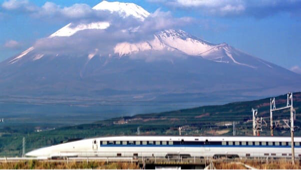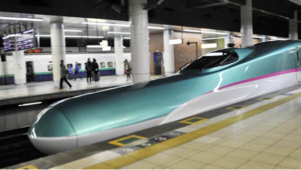How Japan's Shinkansen bullet trains changed the world of rail travel
日本的新干线动车如何改变了火车运输

— Early on October 1, 1964, a sleek blue and white train slid effortlessly across the urban sprawl of Tokyo, its elevated tracks carrying it south toward the city of Osaka and a place in the history books.
1964年10月1日,一辆表面光滑的蓝白相间的火车飞速穿过东京城,其高价轨道向南经过大阪市和历史书中记载的其他地方。
This was the dawn of Japan's "bullet train" era, widely regarded as the defining symbol of the country's astonishing recovery from the trauma of World War II. In tandem with the 1964 Tokyo Olympic Games, this technological marvel of the 1960s marked the country's return to the top table of the international community.
日本“动车时代”的到来,标志着日本从第二次世界大战中以惊人的速度获得复苏。这个20世纪60年代的技术进步和1964年东京奥运会,充分证明了日本这个国家又再次处于国际先进社会的行列。
In the 55 years since that first train, the word Shinkansen -- meaning "new trunk line" -- has become an internationally recognized byword for speed, travel efficiency and modernity.
首列动车运行后的55年时间里,大家把表示“新干线”的这个词汇“Shinkansen”公认为速度、运输效率及现代性的代名词。
Japan remains a world leader in rail technology. Mighty conglomerates such as Hitachi and Toshiba export billions of dollars worth of trains and equipment all over the world every year.
日本的火车制造技术一直处于世界领先地位,其日立和东芝等强大的企业集团每年向世界各地出口价值数十亿美元的火车和相关设备。
The Shinkansen network has expanded steadily since the 320-mile Tokaido line, linking Tokyo and Shin-Osaka was completed in 1964. Trains run at up to 200 mph (about 322 kph) on routes radiating out from the capital -- heading north, south and west to cities such as Kobe, Kyoto, Hiroshima and Nagano.
1964年连接东京和新大阪的长达320英里的东海道线竣工后,新干线就一直在稳步扩张。从首都向北到神户,向南到京都,向西到广岛和长野,列车在这些线路上以高达200英里(约322公里)的时速行驶而过。
As well as a symbol of recovery, Shinkansen have been used as a tool for Japan's continuing economic development and an agent of change in a country bound by convention and tradition.
同时作为日本复苏的象征,新干线动车带动了日本经济的可持续发展,也给日本这个深受传统束缚的国家带来了变革。
Its development owes a great deal to Japan's early railway history. Rather than the 4ft 8.5in "standard" gauge used in North America and much of Europe, a narrower gauge of 3ft 6in was chosen.
日本的发展很大程度上得益于其早期的地铁发展历程。不同于北美和欧洲大部分地区使用的4英尺×8.5英寸的“标准”轻轨,日本选用了更窄的3英尺×6英寸的轻轨。
Although this was cheaper and easier to build through mountainous terrain, capacity was limited and speeds were low.
虽然对山区来说,这种轻轨成本更低,建造难度更小,但是其承载量会受到限制,且时速也会降低。
With Japan's four main islands stretching around 1,800 miles from end-to-end, journeys between the main cities were long and often tortuous.
日本的四大岛屿所跨距离长达1800英里,大部分城市间的距离又长又崎岖。
In 1889, the journey time from Tokyo to Osaka was 16 and a half hours by train -- better than the two to three weeks it had taken on foot only a few years earlier. By 1965, it was just three hours and 10 minutes via the Shinkansen.
1889年,从东京到大阪需要16个半的火车,比几年前要步行两三个星期快得多。1965年,从东京到大阪只需3小时零10分的动车。
Demands for a "standard gauge" rail network started in the 20th century, but it was not until the 1940s that work started in earnest as part of an ambitious Asian "loop line" project to connect Japan to Korea and Russia via tunnels under the Pacific Ocean.
对“标准轻轨”铁路网的需求始于20世纪,但直到20世纪40年代,作为伟大亚洲“环线”项目的一部分,相关工作才真正开始。该项目通过太平洋下的隧道将日本与韩国、俄罗斯连接起来。
Defeat in World War II meant that plans for the new railroad were shelved until the mid-1950s, when the Japanese economy was recovering strongly and better communications between its main cities was becoming essential.
第二次世界大战中的失败搁置了日本发展新铁路的计划,直到20世纪50年代中期,日本经济获得强劲复苏,大部分城市间便利的交通意义重大。
Although much of the network serves the most populous regions of Honshu, the largest of Japan's islands, lengthy sea tunnels allow bullet trains to run hundreds of miles through to Kyushu in the far south and Hokkaido in the north.
虽然日本最大岛屿本州岛人口最密集的地区才能享受到大部分的铁路网服务,但由于其海上隧道足够长,动车可以在隧道上行驶几百英里的车程,向南可以到达九州,向北可以到达北海道。
Japan's challenging topography and its widely varying climates, from the freezing winters of the north to the tropical humidity farther south, have made Japanese railroad engineers world leaders at finding solutions to new problems as they push the boundaries of rail technology.
日本的地形复杂,且气候多变,北方冬季寒冷,南方则是湿热天。这些客观因素促使日本铁路工程师努力发展铁路技术,不断想出新方案,解决新问题,从而成为世界顶级工程师。
Not least of these is seismic activity. Japan is one of the most geologically unstable places on the planet, prone to earthquakes and tsunamis and home to around 10% of the world's volcanoes.
最为严重的是地震活动。日本是地球上地质最不稳定的地区之一,容易发生地震和海啸,世界上约10%的火山都发生在这里。
While this provides arguably the defining image of the Shinkansen -- a high-tech modern train flashing past the snow-capped Mount Fuji -- it also makes the safe operation of high-speed trains much more difficult.
虽然这可以展现新干线的形象--一辆高科技的现代列车闪过白雪皑皑的富士山--但它也使高速列车的安全运行变得更加困难。
Despite these factors, not a single passenger has ever been killed or injured on the Shinkansen network over its 55-year history.
尽管如此,但在新干线55年的发展历史上,从未出现过乘客伤亡事件。

The next generation of bullet trains, known as ALFA-X, is currently being tested at speeds of almost 250 mph (400 kph), although the service maximum will be "only" 225 mph.
被称为Alfa-X的新一代动车虽然目前正以近250英里/小时(400公里/小时)的速度进行试运行,但实际运行的最高时速将只能为225英里/小时。
The defining features of these and other recent Shinkansen trains are their extraordinarily long noses, designed not to improve their aerodynamics, but primarily to eliminate sonic booms caused by the "piston effect" of trains entering tunnels and forcing compression waves out of the other end at supersonic speeds.
这些和其他最新的新干线动车的显著特征是它们的超长动车头,其设计不是为了改善它们的空气动力学,而是主要为了消除列车进入隧道时的“活塞效应”引起的音爆,并迫使压缩波以超音速从另一端出来。
This is a particular problem in densely populated urban areas, where noise from Shinkansen lines has long been a source of complaints.
The experimental ALFA-X train also features new safety technology designed to cut down on vibration and noise and reduce the likelihood of derailments in major earthquakes.
在人口稠密的城市地区,这个问题尤其突出,在那里,新干线的噪音长期以来一直是其受到投诉的一个原因。
试运行的Alfa-X列车还采用了新的安全技术,旨在减少振动和噪音,并降低在大地震中脱轨的可能性。
More than 10 billion passengers have now been carried in speed and comfort by the trains, the predictability of the operation making high-speed travel seem routine and largely taken for granted.
目前,列车已经运送了超过100亿名乘客,给他们带来快速又舒适的旅途享受。运营的可预测性使得高速旅行看起来像是例行公事,而且大家都认为认为这是理所当然的。
Ben Jones, CNN • Updated 27th November 2019
本·琼斯于2019年11月27日更新
Ben Jones is a freelance railway and travel writer, senior correspondent at The Railway Magazine and regular contributor to numerous other railway publications in the UK. Follow him on Twitter @flywheelmedia1
本·琼斯是一名专注铁路和旅行的自由作家,同时也是《铁路杂志》的一名资深记者,定期为英国许多铁路出版物撰稿。了解他可以关注他的Twitter账号@flywhelmedia1